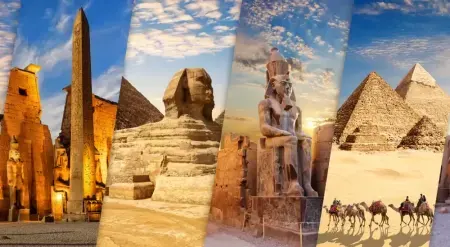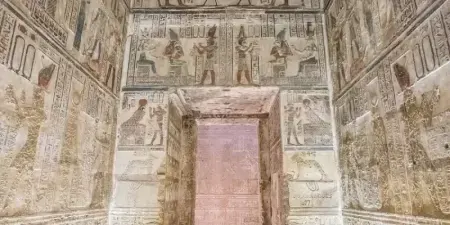Introduction
If you're fascinated by the mysteries of ancient Egypt, then visiting the Temple of Seti in Abydos is a must-do. This temple is considered to be one of the most important religious sites in all of Egypt, and it's easy to see why. The stunning architecture and intricate carvings are a testament to the skill and dedication of the ancient Egyptians who built it. In this article, we'll take you on a journey through time and history as we explore the mystical wonders of the Temple of Seti in Abydos.
The History of the Temple of Seti in Abydos
Situated about 400 KM south of Cairo, the Temple of Seti in Abydos is one of the most breathtaking yet underrated shrines in Egypt. It was known to the Greeks as the Memnonium and is dedicated to Seti I, Osiris, Isis, Ptah, Ptah-Sokar, Nefertem, Re-Horakhty, Amun, and Horus. Historians view it as one of the most essential archaeological sites in the area of Abydos.
Seti I, who ruled Egypt during the Nineteenth Dynasty from 1290-1279 BCE, was an enthusiastic builder, initiating mines and quarries and renovating dilapidated temples and shrines. His son, Ramses II, the third king of the Nineteenth Dynasty, is renowned for having one of the longest reigns in ancient Egypt. It is believed that Seti constructed the temple himself, while his son Ramses II was most likely responsible for finishing the decorations and ornamentations as well as the nearby courtyards.
The Temple of Seti is found in the sacred ancient city of Abydos, where it is only three hours away by car from Luxor. This city is likewise the burial place for the initial kings of Egypt when its upper and lower kingdoms were merged into one. Near the Temple of Seti is a very old cemetery with hundreds of graves dating back to predynastic times.
Much like how Muslims aspire to make a pilgrimage to Mecca, the ancient Egyptians had the same hopes and dreams of making the pilgrimage to Abydos, which was considered an entrance to the afterlife.
Seti I came to rule Egypt only 30 years after the chaos of the Amarna Period, which was led by the sacrilegious Akhenaten. Because of this, Seti was very committed to restoring faith in the pantheon of pre-Akhenaten gods that the previous pharaoh had tried to demolish. As a result, the Temple of Seti consists of a series of smaller shrines or chapels dedicated to each of the major gods, including one to Seti himself.
The current facade of the temple was once the backdrop of the second of the two distinct courtyards, while the first courtyard and its entrance pylon are now in ruins. A lot of the temple complex is no longer present, forcing tourists to enter through a designated doorway directly into the hypostyle hall. Despite the ruins, many of the wall reliefs in the interior are still well-preserved, with the reliefs in the back of the temple established during Seti’s rule being considered some of the most important of the hundreds of temples still standing in Egypt.
Architecture and design of the temple
The Temple of Seti in Abydos was designed to be a place of worship and pilgrimage, and the architecture reflects this. The temple complex is centered around a large sanctuary, which was believed to be the resting place of Osiris. The sanctuary was surrounded by a hypostyle hall, which had 24 large columns decorated with carvings and hieroglyphics.
There were also several smaller chapels and shrines within the temple complex, including a chapel dedicated to Seti I himself. The walls and columns of these chapels were also covered in intricate carvings and inscriptions, which provided information about the gods and their relationship with the pharaohs.
The architecture of the temple was designed to be both functional and beautiful. The use of light and shadow, as well as the intricate carvings and hieroglyphics, created a sense of mystery and awe. The temple was also designed to be a place of quiet contemplation, where visitors could connect with the divine.
The temple is in the shape of an L, featuring a ramp, two pylons, a landing quay, terrace, two courts, twin hypostyle halls, a series of connected chambers on the southern end, and seven chapels for worshiping the gods of Ancient Egypt and Seti himself.
There are also storage chambers that stretch from the temple’s southernmost end to the front entrance. The primary body of the temple was also remarkably symmetrical up to the seven chapels, showcasing the importance of sacred geometry to the ancient Egyptians.
The Temple of Seti was built using fine white limestone, which gives it a heavenly look. As visitors enter the temple through the outercourtyard in ruins, they will see large tanks for the worship of the temple's priest, which is the first shrine in Egypt to feature these structures. As you make your way through the temple, you will come across numerous rows of mud brick storage chambers clustered around a stone entrance hall, which you can only access by a long flight of 42 stairs.
Ramesses II’s additions to the Temple of Seti include the outermost pylons and courts plus the first of the two hypostyle halls, where he added a relief of himself worshipping his father, Osiris, and Isis. His decorations and embellishments were done more hastily and are not as sophisticated as his father’s, but they are still meaningful and worth viewing. For instance, there is an illustration of a young Ramesses II tying up a bull with his father and numerous military depictions in the second courtyard.
Visiting the Temple of Seti I at Abydos
If you're planning a trip to Egypt, then visiting the Temple of Seti in Abydos should definitely be on your itinerary. The temple is located in Upper Egypt, near the modern city of Sohag. It's easily accessible by car or public transportation.
When you arrive at the temple, you'll be struck by its sheer size and beauty. The carvings on the walls and columns are incredibly intricate, and the use of color and light is stunning. You'll have the opportunity to explore the various chapels and shrines within the temple complex, and to learn about the history and significance of the temple from your guide.
It's important to remember that the Temple of Seti in Abydos is a religious site, so visitors should dress modestly and respect the customs of the locals. It's also a good idea to bring plenty of water and sunscreen, as the temple can get quite hot during the day.
Other nearby attractions to visit
If you're planning a trip to the Temple of Seti in Abydos, then there are several other nearby attractions that you should consider visiting. One of the most popular is the nearby Temple of Ramses II, which was built by the son of Seti I. This temple is also dedicated to the god Osiris, and is known for its stunning statues and carvings.
Another nearby attraction is the Abydos Archaeological Site, which is home to several other ancient Egyptian temples and tombs. The site is located on the west bank of the Nile, and is accessible by car or boat.
Conclusion: Visiting the Temple of Seti in Abydos is a must-do
Visiting the Temple of Seti in Abydos is an unforgettable experience. The temple is not only a masterpiece of ancient Egyptian art and architecture, but it's also a place of deep spiritual significance. The carvings and inscriptions on the walls provide a wealth of information about the history and culture of ancient Egypt, and the temple's beauty and grandeur are a testament to the skill and dedication of the ancient Egyptians who built it.
If you're planning a Vacation to Egypt, then visiting the Temple of Seti in Abydos should definitely be on your itinerary. It's an opportunity to connect with the divine, to learn about the history and culture of one of the world's greatest civilizations, and to be awed by the beauty and wonder of ancient Egypt.











.jpg)



